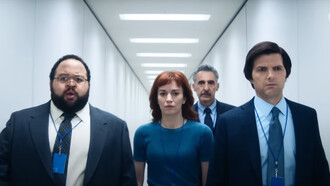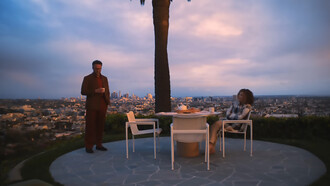In Japan, I learned that once the people like you, they will keep liking you…forever. They never forget.
(Giovanni Mirabassi)
Alas, after three years stricken by health and social restrictions that dwindled the music scene, international artists are gradually rolling the carpet once more for their much-awaited comeback to Japan. The biggest and most prominent jazz house in Tokyo, Blue Note Tokyo, has bravely survived the pandemic, mostly with local artists, but has resumed its exciting line-up of live music shows by foreign musicians as well.
Not a newcomer to Japan residents, world-class jazz pianist Giovanni Mirabassi happily returned to Blue Note Tokyo and the country since the peak of the global epidemic. Having met him for the first time in 2011, I continued to be charmed by Giovanni’s debonaire stature and incredible performance that had not shriveled amidst the twelve-year capsule. He is still lively, enthusiastic, and diligently focused on his passions.
His extraordinary encounter with Japan and the Japanese people may be programmed or destined, having dreamt of coming to the country since he was a child. Since 1999, he has been delighting audiences in Japan, and has been a solid favorite at the Blue Note Tokyo and Cotton Club. The tight connection is, undoubtedly, a romantic relationship that Giovanni himself sees as eternal.
He relates, “It started with my first record, Architectures (1999) when Atelier Sawano (jazz record label based in Osaka) told me how they liked my music, and proposed I try performing in Japan. And, so I did, around 1998-1999. The Japanese audience loved my music. Then, I did my first Japan tour in 2003, playing at the Sumida Triphony Hall. After five years, in 2008, I was touring a lot and established direct contact with the Japanese music business. In Japan, I learned that once the people like you, they will keep liking you.. forever. They never forget. Even before this happened, I was already in love with Japan. I come from the anime generation since I was seven to nine years old. I had always been dreaming of this country, and throughout the years of meeting many people here, I have really learned to love Japan. Even today, when I have like one week free, I come for pleasure, and so I’ve travelled to Fukuoka, Hokkaido, Okinawa…
As for Blue Note Tokyo, it is my favorite club in the world. In 2009, I came with my trio (Gianluca Renzi and Leon Parker). They also loved it here so much that they voted we play again at the Blue Note in the next two years. At the same time, I was also playing at Cotton Club, both with my trio and solo. I have a good distribution in Japan. I also launched my own label in Paris, Jazz Eleven, which produces many artists, including Japanese, such as Toku (trumpeter).”
Unknown to many, Giovanni met and worked with Ghibli creator, Hayao Miyazaki. This episode professed his prolonged endearment of Japanese animation. In 2015, Giovanni and his trio, released the cover album Animessi ~Le Chateau dans le Ciel (Tenku No Shiro No Laputa Hoka~), which centered on the Ghibli film scores. He performed a concert in Japan for this album, which director Miyazaki, who had been a great fan of Mirabassi, also attended. With the album’s immense success, Giovanni created another Ghibli-inspired album, Mitaka Calling-Mitaka no Yobigoe. It also features Ghibli film soundtracks, with Miyazaki’s fabulous jacket illustration. Miyazaki commented, “I love Mirabassi-san's piano. Freedom and passion. That's exactly what he is."
Giovanni recalls his encounter with Miyazaki
I had always loved the music of Joe Hisaishi, even before he was a star. To me, he is like Ennio Morricone. He writes magical melodies. In 2007, I told my producer that I wanted to make a record of Hisaishi’s music. At that time, he was not convinced, telling me that playing anime music was not my level. But, anime is like Hollywood. Seven years later, the same producer suddenly asked me if I still wanted to do Hisaishi’s music, because then, the image of anime changed with its growing popularity and Miyazaki’s fame. I had a meeting with Miyazaki, and my album Animessi came out. Howl’s Moving Castle was one of my best hits, which I did in 2005 with trumpeter Flavio Boltro. He came with me to Japan several times. Before recording that song, I went to see the movie in Paris. I thought then, wow, this could be a standard piece. I recorded it and it became a hit.
Giovanni was born and raised in Perugia, Italy. He moved to Paris at the age of 21. Surprisingly, he has never done a prominent concert in his home country. How did this pivotal jump to Paris come about? And what does “la vie Parisienne” mean to him today?
I have never been invited to play in Italy, except one time when I was called by Paolo Fresu (trumpeter) to participate in his charity concert event for the earthquake in Aquila. Yet, I have played in New York, Sydney, Buenos Aires, many other cities, and Japan, of course. Many of the Italian musicians I’ve collaborated with actually live or have lived outside Italy, like Flavio (Boltro), who also lives in Paris. When I was young, my parents didn’t approve of my desire to become a musician. So, I decided to leave for Paris. I was 21, young, I could go anywhere I wanted, and just see what would happen. At that time, Paris was the best place to be in Europe for jazz, and the scene was not happening in Italy then. In Paris, the music business was open to the world. Moving there was the best decision I could ever have imagined. When I arrived in Paris, I didn’t have any papers, couldn’t speak the language, and didn’t have a CV with me, but I worked to start my career there until I became famous internationally. Now, I carry my own label and produce young artists. That could not happen to me in Italy. I’m very happy in Paris. I have been adopted by the French people. I love the sceneries, the language…I have been living my life there for thirty-one years. There is no color, religion and wealth in the law in France. The law is the same for all, and everyone has the privilege to be his own person.
Like all musicians of the 80s-90s generation, Giovanni faces challenges in measuring up to the digital platform in the music industry today. However, he believes the digital system is not fit for the jazz scene.
Unfortunately, we have not yet adapted fully to the digital platform today, but I am aware that we have to. But, I think jazz is not made for such digital platforms. Jazz is like an artisan’s work, a craft, handmade music. The Internet is like a highway, where you need to do shortcuts. Our audience, though, caters more to the older generation, and we also need to touch the younger crowd. Most digital music services, though, like Spotify, may not be enough to support musicians, especially to cover production costs. So, we have to find ways to be creative financially. Sadly, music can’t pay for itself anymore.
At the Blue Note Tokyo show last May 1st, Giovanni glittered the night with standard tunes and songs from his 2020 album Pensieri Isolati, his latest album, The Swan and the Storm, and other original tracks, such as Canzone and Place de la Mairie. Pensieri Isolati resulted from a climacteric point during the lockdown when Giovanni found himself confined and deprived of his passion, playing music for other people. Every week, he escaped from his home to his studio to record a piece embracing his feelings of isolation. He invited the public to share secluded thoughts on the album’s Instagram account. The songs, therefore, serve as poetic journals that surmise a harrowing period in people’s lives at that time.
The Swan and the Storm, which has not yet been released in Japan (only in Europe) as of this writing, is inspired by the war in Ukraine, from Giovanni’s encounter with the local people when he played in Odessa. Together with his quartet (Guillaume Perret, Clément Daldosso, and Lukmil Perez), the album also shines with a beautiful animated illustration on the jacket. Like the album title, Giovanni is the swan that would certainly fly across more continents of success and endless pursuits.















